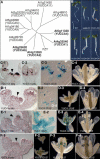Auxin biosynthesis by the YUCCA flavin monooxygenases controls the formation of floral organs and vascular tissues in Arabidopsis
- PMID: 16818609
- PMCID: PMC1522075
- DOI: 10.1101/gad.1415106
Auxin biosynthesis by the YUCCA flavin monooxygenases controls the formation of floral organs and vascular tissues in Arabidopsis
Abstract
Auxin biosynthesis in plants has remained obscure although auxin has been known for decades as a key regulator for plant growth and development. Here we define the YUC gene family and show unequivocally that four of the 11 predicted YUC flavin monooxygenases (YUC1, YUC2, YUC4, and YUC6) play essential roles in auxin biosynthesis and plant development. The YUC genes are mainly expressed in meristems, young primordia, vascular tissues, and reproductive organs. Overexpression of each YUC gene leads to auxin overproduction, whereas disruption of a single YUC gene causes no obvious developmental defects. However, yuc1yuc4, yuc2yuc6, all of the triple and quadruple mutants of the four YUC genes, display severe defects in floral patterning, vascular formation, and other developmental processes. Furthermore, inactivation of the YUC genes leads to dramatically reduced expression of the auxin reporter DR5-GUS in tissues where the YUC genes are expressed. Moreover, the developmental defects of yuc1yuc4 and yuc1yuc2yuc6 are rescued by tissue-specific expression of the bacterial auxin biosynthesis gene iaaM, but not by exogenous auxin, demonstrating that spatially and temporally regulated auxin biosynthesis by the YUC genes is essential for the formation of floral organs and vascular tissues.
Figures





References
-
- Alonso J.M., Stepanova A.N., Leisse T.J., Kim C.J., Chen H., Shinn P., Stevenson D.K., Zimmerman J., Barajas P., Cheuk R., et al. Genome-wide insertional mutagenesis of Arabidopsis thaliana. Science. 2003;301:653–657. - PubMed
-
- Bartel B. Auxin biosynthesis. Annu. Rev. Plant Physiol. Plant Mol. Biol. 1997;48:51–66. - PubMed
-
- Benkova E., Michniewicz M., Sauer M., Teichmann T., Seifertova D., Jurgens G., Friml J. Local, efflux-dependent auxin gradients as a common module for plant organ formation. Cell. 2003;115:591–602. - PubMed
-
- Bennett S.R.M., Alvarez J., Bossinger G., Smyth D.R. Morphogenesis in pinoid mutants of Arabidopsis thaliana. Plant J. 1995;8:505–520.
Publication types
MeSH terms
Substances
Grants and funding
LinkOut - more resources
Full Text Sources
Other Literature Sources
Molecular Biology Databases
